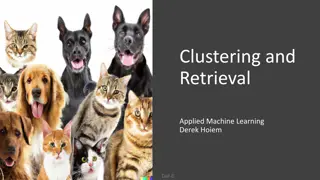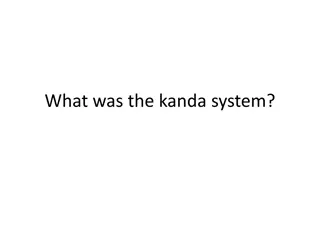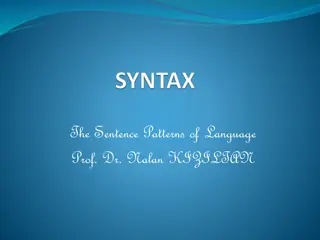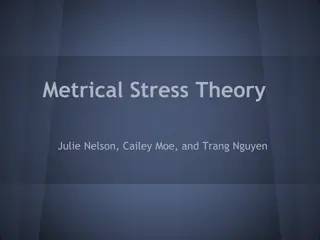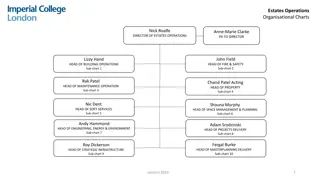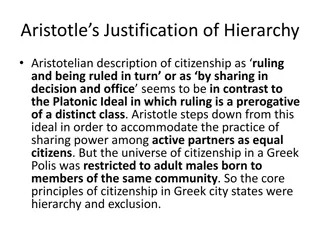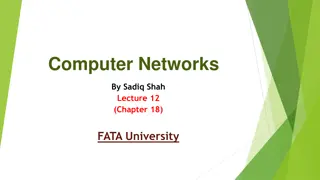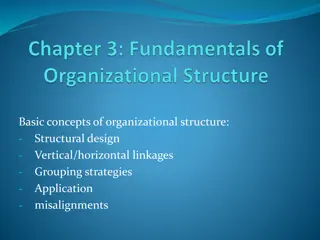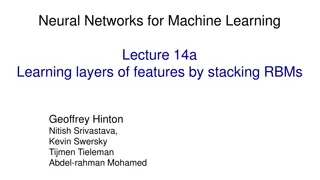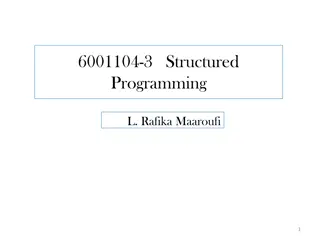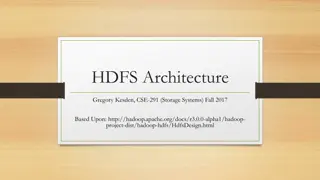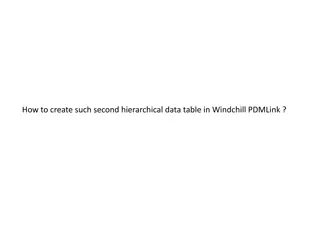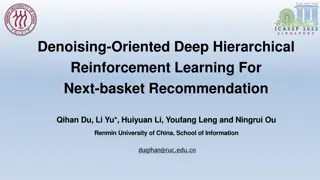Domain-Agnostic Information Model for Vehicle Data Transformation
The push towards a domain-agnostic information model from a vehicle-centric data approach is explored due to emerging industry requirements. COVESA projects like AUTOSAR Vehicle API and EV charging necessitate a shift. The proposal introduces the Hierarchical Information Model (HIM) to organize data
0 views • 10 slides
Prioritizing Clinically Important Outcomes Using Hierarchical Win Ratio
Clinical trials often use composite outcomes, but conventional analysis methods have limitations in accurately reflecting clinical reality. Hierarchical outcomes offer flexibility by defining a hierarchy of events based on importance. Analyzing trials using hierarchical outcomes involves comparing p
7 views • 20 slides
The Diocesan Organisation
In the depicted Diocesan organization chart, Jonathan Wood serves as the Diocesan Secretary/CEO, leading the Senior Leadership Team consisting of various directors overseeing strategy implementation, ministry and mission, church revitalization, people and engagement, education, communications, and f
0 views • 13 slides
Efficacy and Safety of Ferric Carboxymaltose for Heart Failure with Iron Deficiency
Iron deficiency is prevalent in heart failure patients with reduced ejection fraction and is linked to poor outcomes. The HEART-FID trial investigates the impact of intravenous ferric carboxymaltose (FCM) on all-cause mortality, heart failure hospitalizations, and exercise capacity in chronic HFrEF
1 views • 17 slides
Administration: Ancient, Medieval and colonial
The evolution of administration in India traces back to the earliest monarchial systems in the Vedic period, progressing through texts like Arthshastra and principles of hierarchy. Ancient administrators emphasized decentralization and hierarchical structures. Arthshastra acted as a manual for admin
2 views • 17 slides
HSE & Security Organization Structure Overview
This document outlines the hierarchical structure of the HSE and Security organization as of October 1, 2023. It includes details on key personnel, regions of responsibility, and specific roles within the organization. The organization's chart provides a comprehensive view of the leadership team and
7 views • 4 slides
Understanding Organizational Concepts and Characteristics
Exploring the essence of organizations, this content delves into the concept, characteristics, and theories of organizational development. It covers the importance of planning, organizational behavior, and the key elements that shape organizations. Highlighting well-defined statutes, work ethics, an
6 views • 9 slides
Don’t Confuse More Data with Better Insights — How to Streamline Your Marketing Dashboards
In today's data-driven world, more data doesn't always mean better insights. Learn how to streamline your marketing dashboards by focusing on core KPIs, ensuring data accuracy, and adopting a user-centric design. Discover practical tips for prioritizing metrics, implementing hierarchical layouts, an
3 views • 8 slides
Understanding Clustering Algorithms: K-means and Hierarchical Clustering
Explore the concepts of clustering and retrieval in machine learning, focusing on K-means and Hierarchical Clustering algorithms. Learn how clustering assigns labels to data points based on similarities, facilitates data organization without labels, and enables trend discovery and predictions throug
1 views • 48 slides
Understanding the Kanda System in Matrilineal Societies
The Kanda system was a key aspect of matrilineal descent groups that controlled land and kinship relations in C16 societies. Kandas had flexible structures, varying from hierarchical to egalitarian, with chiefs playing different roles. Key features included defined names, traditions, and autonomy in
2 views • 14 slides
The Evolution of Finance Function Structures in the Digital Era
Explore the changing landscape of finance function structures in the digital age, from hierarchical shapes to shared services and outsourcing. Learn about the importance of organizational structure and different types of structures like entrepreneurial, functional, divisional, and matrix. Dive into
1 views • 22 slides
Understanding Sentence Patterns in Language: A Guide by Prof. Dr. Nalan Kiziltan
Language consists of sentences organized by grammar rules. Syntax plays a crucial role in sentence structure. This guide explores sentence patterns, syntax principles, linear order, and hierarchical structure in language, illustrated with examples and constituent tests.
0 views • 111 slides
Exploring Metrical Phonology: A Brief Overview
Metrical phonology, a subtheory of generative phonology, focuses on categorizing stress and stress rules within rhythmic hierarchies. It differs from generative phonology by not treating stress as a segmental feature specific to vowels. Originating from Halle's linear analysis, metrical stress theor
0 views • 32 slides
Organisational Structure of Estates Operations Team
The organisational chart depicts the hierarchical structure of the Estates Operations team, led by the Director of Estates Operations. It showcases the various heads and managers responsible for building operations, maintenance, soft services, space management, projects delivery, engineering, energy
0 views • 20 slides
Aristotle's Justification of Hierarchy and Republican Aspects of Citizenship
Aristotle's concept of citizenship involves a hierarchical structure where ruling and being ruled in turn is essential. He justifies this hierarchy by emphasizing the advantageous nature of ruling and being ruled. However, his views on citizenship in Greek city-states were limited to adult males, hi
3 views • 6 slides
Major Formation Types of the World by Dr. Zaryab Khalid - BS Botany Semester 7
This presentation by Dr. Zaryab Khalid explores the major formation types of the world in the field of community ecology. It delves into the classification of natural and cultural vegetations, the concept of formation classes and subclasses, and details the six natural formation classes along with e
2 views • 7 slides
Understanding IPv4 Addresses and Classful Addressing in Computer Networks
Explore the basics of IPv4 addresses, address space, hierarchy in addressing, and classful addressing in computer networks. Learn about the unique 32-bit structure of IPv4 addresses, address space calculation, notation methods, and the hierarchical nature of network addressing. Dive into the concept
2 views • 14 slides
Understanding UNIX and Linux Operating Systems
UNIX, known as the mother of most operating systems, follows a design philosophy rooted in plain text data storage, hierarchical file systems, and modular programs. The UNIX kernel controls system functions, while Linux, a Unix-like OS, operates as a free and open-source alternative developed from s
2 views • 4 slides
Understanding Organizational Structure and Vertical/Horizontal Linkages
Organizational structure encompasses formal reporting relationships, department grouping, and system design for effectiveness. By structuring for efficiency, organizations prioritize vertical communication and centralized decision-making. In contrast, a learning structure emphasizes horizontal commu
0 views • 30 slides
Understanding Stacked RBMs for Deep Learning
Explore the concept of stacking Restricted Boltzmann Machines (RBMs) to learn hierarchical features in deep neural networks. By training layers of features directly from pixels and iteratively learning features of features, we can enhance the variational lower bound on log probability of generating
0 views • 39 slides
Understanding Inheritance in Object-Oriented Programming
Inheritance in Java is a key concept where a subclass can inherit properties and behaviors from a superclass. This mechanism allows for hierarchical organization and the creation of modular classifications. The relationship between superclasses and subclasses is crucial in defining object-oriented d
4 views • 19 slides
Classical Approach in Business Management
The Classical Approach in Business Management focused on improving efficiency, decreasing costs, and increasing profits by adopting scientific principles. It emphasized planning, organizing, and controlling as key functions of management. The hierarchical organizational structure with a pyramid shap
5 views • 34 slides
Data Science Course Updates and Events Overview
Stay informed with the latest updates and events from the ECE-5424G/CS-5824 course at Virginia Tech. Learn about topics such as EM and GMM, administrative deadlines, distinguished lectures, K-means algorithm, and hierarchical clustering. Mark your calendar for key dates like final project discussion
0 views • 51 slides
Secure Computation Techniques in RAM Models with Efficient Automation
Explore the automation of efficient RAM-model secure computation techniques, including examples such as secure binary search. Discover how traditional solutions using circuit abstractions can be improved for sub-linear time computation through methods like Oblivious RAM. Learn about techniques such
0 views • 37 slides
Understanding H5 Files: A Practical Overview
H5 files, which stand for Hierarchical Data Format 5, store data in a structured manner, commonly used for storing weights in machine learning models. Exploring the contents of H5 files and dealing with unknown hierarchies can be challenging but essential tasks in data analysis. This presentation pr
0 views • 8 slides
Overview of HDFS Architecture
HDFS (Hadoop Distributed File System) is designed for handling large data sets across commodity hardware. It emphasizes throughput over latency and is well-suited for batch processing applications. The architecture includes components like NameNode (master) and DataNode (participants), focusing on s
0 views • 15 slides
Design and Evaluation of Hierarchical Rings with Deflection Routing
This research explores the implementation of Hierarchical Rings with Deflection (HiRD) routing as a solution to the performance and energy inefficiencies found in traditional hierarchical ring designs. HiRD guarantees livelock freedom and efficient delivery while simplifying the network structure by
0 views • 52 slides
Creating Second Hierarchical Data Table in Windchill PDMLink
Learn how to set up a second hierarchical data table in Windchill PDMLink by selecting rows from the first table to view and interact with related objects in a structured manner. The process involves customization and user actions within the tables to manage parts and documents efficiently.
0 views • 8 slides
Hierarchical Attention Transfer Network for Cross-domain Sentiment Classification
A study conducted by Zheng Li, Ying Wei, Yu Zhang, and Qiang Yang from the Hong Kong University of Science and Technology on utilizing a Hierarchical Attention Transfer Network for Cross-domain Sentiment Classification. The research focuses on sentiment classification testing data of books, training
0 views • 28 slides
Data Summarization with Hierarchical Taxonomy: Motivations and Examples
The research discusses the use of Hierarchical DAGs in summarizing data with a focus on disease ontology and animal diseases. It explores how general concepts can summarize specific items and their relationships. The study also presents motivated examples of popular papers summarization in SIGMOD, s
0 views • 27 slides
Classifying Entities into an Incomplete Ontology: Exploratory EM Approach
The research discusses methods for hierarchical classification of entities into incomplete ontologies. It explores the challenges of evolving web-scale datasets and the need for classifying entities in an incomplete ontology structure. The Hierarchical Exploratory EM model is detailed, providing ins
0 views • 27 slides
Denoising-Oriented Deep Hierarchical Reinforcement Learning for Next-basket Recommendation
This research paper presents a novel approach, HRL4Ba, for Next-basket Recommendation (NBR) by addressing the challenge of guiding recommendations based on historical baskets that may contain noise products. The proposed Hierarchical Reinforcement Learning framework incorporates dynamic context mode
0 views • 16 slides
Hierarchical Semi-Supervised Classification with Incomplete Class Hierarchies
This research explores the challenges and solutions in semi-supervised entity classification within incomplete class hierarchies. It addresses issues related to food, animals, vegetables, mammals, reptiles, and fruits, presenting an optimized divide-and-conquer strategy. The goal is to achieve semi-
0 views • 18 slides
Building Hierarchical Ratings Model without Alternatives Listed
Learn to build a hierarchical ratings model with 4 criteria, including subcriteria for Comfort, using a step-by-step approach. Explore how to select covering criteria, create performance scales, add and rate alternatives, and prioritize rating intensities for effective evaluation. Streamline your ra
0 views • 12 slides
Efficient and Effective Duplicate Detection in Hierarchical Data
This study explores the efficient and effective detection of duplicates in hierarchical data, focusing on fuzzy duplicates and hierarchical relationships in XML. It discusses the current and proposed systems, including the use of Bayesian networks for similarity computations. The methods involve vec
0 views • 25 slides
Graph Summarization on Hierarchical DAGs
Explore top-k graph summarization techniques on Hierarchical Directed Acyclic Graphs (DAGs) like Disease Ontology, ImageNet, and Wikipedia Categories. Understand motivations for summarization, related works, and the kDAG-Problem. Discover algorithms, experiments, and conclusions for efficient graph
0 views • 38 slides
Understanding Hierarchical vs. Non-Hierarchical Models in Computer Graphics
Dive into the concepts of hierarchical and non-hierarchical modeling in computer graphics. Explore how hierarchical models represent complex objects with explicit sub-part dependencies, while non-hierarchical models treat objects independently. Understand the benefits and challenges of each approach
0 views • 30 slides
Utilizing Bayesian Hierarchical Model for Clinical Trial Quality Design
Explore how a Bayesian Hierarchical Model can be leveraged to design quality into clinical trials and ensure compliance with ICH E6 R2 Quality Tolerance Limits. Learn about the Risk-Based approach, Quality Tolerance Limits methodology, and the application of Bayesian modeling for early phase studies
0 views • 14 slides
Hierarchical Body Modeling in OpenGL Homework 3
Explore the concepts of hierarchical body modeling in OpenGL Homework 3 by creating body part hierarchies, recording transformation matrices, and understanding the hierarchy structures. The homework focuses on building hierarchies for body parts like thighs and shanks, applying transformations, and
0 views • 23 slides
Machine Learning Approach for Hierarchical Classification of Transposable Elements
This study presents a machine learning approach for the hierarchical classification of transposable elements (TEs) based on pre-annotated DNA sequences. The research includes data collection, feature extraction using k-mers, and classification approaches. Proper categorization of TEs is crucial for
0 views • 18 slides








